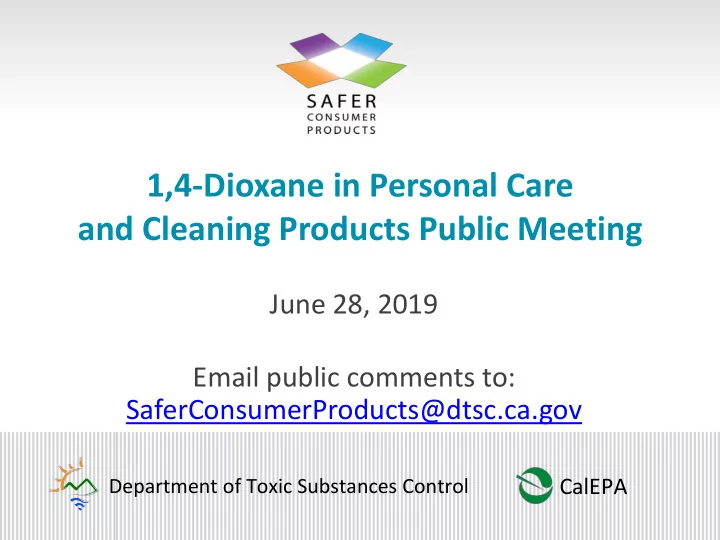

1,4-Dioxane in Personal Care and Cleaning Products Public Meeting June 28, 2019 Email public comments to: SaferConsumerProducts@dtsc.ca.gov CalEPA Department of Toxic Substances Control
Safer Consumer Products Program Overview 2
Purpose of today - Hear concerns related to 1,4-dioxane in consumer products - Potential for adverse impacts - Concerns associated with 1,4-dioxane in wastewater - Potential impacts of 1,4-dioxane on beneficial reuse of wastewater 3
Meeting Format - DTSC 1,4-dioxane overview - Presence in products, exposure concerns, potential for adverse impacts - More information: https://dtsc.ca.gov/scp/1-4-dioxane/ - Stakeholder presentations - General public comment period - In person - Through email: SaferConsumerProducts@dtsc.ca.gov 4
1,4-Dioxane Basics ▪ Small, highly soluble, persistent in water ▪ Volatile ▪ Likely carcinogen per ▪ Doesn’t stick to solids (filters, particulates) the US EPA • any route of exposure ▪ Not removed by most standard water treatment 6
Relevant Work Plan Product Categories Cleaning Products Beauty, Personal Care, Laundry detergents, dish and Hygiene Products detergents Shampoo, body wash, cosmetics 7
1,4-Dioxane Presence in Products ▪ Contaminant formed in the production of ethoxylated surfactants and other raw materials • Not included on label • Often associated with ingredients that end in, or contain, “eth” – Sodium laureth sulfate, polyethylene glycols (PEG) ▪ DTSC product testing 8
1,4-Dioxane Exposure Concerns 9
10
11
12
13
14
1,4-Dioxane in California Drinking Water Counties with 1,4-dioxane detections in drinking water sources and systems Max. detect % of CA County (µg/L) Population Los Angeles 53 26% Orange 26.7 8% Santa Barbara 16 1% Monterey 3.9 1% San Diego 1.2 8% Sacramento 1.1 4% Total 48% State Water Board data (2003-2018)** US EPA 2013-2015 Data* 15 * https://www.epa.gov/dwucmr/occurrence-data-unregulated-contaminant-monitoring-rule ** https://www.waterboards.ca.gov/drinking_water/certlic/drinkingwater/EDTlibrary.html
Sensitive Sub-Populations: Environmental Justice Communities “A mapping tool to help identify California communities… where people are especially vulnerable to pollution’s effects.” US EPA 2013-2015 Data 16 https://oehha.ca.gov/calenviroscreen
Sensitive Sub-Populations: Environmental Justice Communities 17 US EPA 2013-2015 Data
Sensitive Sub-Populations: Children ▪ Present in children’s products ▪ Different product use patterns ▪ Higher surface area/body weight ratio ▪ Increased diffusion through skin 18
Impacts to Water Treatment Agencies ▪ Background 1,4-dioxane concentrations in wastewater effluent • Indicates widespread, constant input ▪ Standard treatments are ineffective • Specialized treatment is costly ▪ Particularly concerned about water treatment agencies generating recycled water • Permits limit 1,4-dioxane concentration 19
Questions to Stakeholders: Key Themes ▪ Theme 1. Potential 1,4-dioxane adverse impacts (today) ▪ Theme 2. Presence of 1,4-dioxane in personal care and cleaning products (August 21) ▪ Theme 3. Alternatives Analysis Threshold (August 21) 20 https://calsafer.dtsc.ca.gov/cms/commentpackage/?rid=12743
Next Steps ▪ Workshop August 21 in Sacramento • https://dtsc.ca.gov/scp/safer-consumer-products- workshops-events/ ▪ CalSAFER Comment Period through August 21 • www.calsafer.dtsc.ca.gov ▪ Consider feedback to inform possible Priority Products 21
QUESTIONS? SaferConsumerProducts@dtsc.ca.gov
Recommend
More recommend